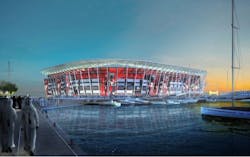Bringing the World Cup to Light: Emergency Lighting for the Ras Abu Aboud Stadium
In the lead-up to the 2022 FIFA World Cup, Qatar has built nine new stadiums and renovated three, with the 12 venues divided among seven host cities. Located on the shores of the Gulf, looking across to Doha's West Bay skyline, the Ras Abu Aboud Stadium is one of the 12 new stadiums, a spectacular venue for matches up to the quarter-finals of the 2022 FIFA World Cup Qatar.
Constructed using shipping containers, removable seats and other modular "building blocks," not only does this 40,000-seat venue have a remarkable design, but it is also zero-carbon emitting and climate-controlled, and will be entirely dismantled and repurposed after the World Cup. Its parts will be used in other sporting or nonsporting projects, setting a new standard in sustainability and introducing bold new ideas in tournament legacy planning.
With the venue's temporary nature and clever modular design in mind, fewer building materials were required compared to traditional stadium buildings, in order to help keep construction costs down.
Reliable emergency lighting
When plans for the stadium began in 2020, UK lighting manufacturer Mackwell was involved right from the start alongside its partner, Archilum Lighting, Mackwell’s Dubai-based expert in lighting solutions. Together, they designed and created all emergency lighting layouts for the stadium as well as its emergency lighting product specification.
Stadiums are notoriously complicated to specify when it comes to emergency lighting. This is why Archilum closely partnered with Mackwell to help with the design and specification of the stadium’s emergency lighting.
Archilum, with the guidance of Mackwell, completely designed all emergency lighting layout and wiring and placed the right luminaires for each of the different areas in line with all LUX calculations to ensure compliant installation, optimizing the use of space throughout the building.
Delivering optimal output
Compliance is the No. 1 factor in any emergency lighting deployment, and the Ras Abu Aboud Stadium was no exception. As all the luminaires carry the highly decorated Kitemark approval from BSI, Mackwell delivered emergency lighting that wasn’t only capable of meeting Qatar Civil Defense’s requirements, but also able to provide the best possible performance within the space.
The Qatar branch of NVC International, a seven-year partner of Mackwell’s, deployed the products locally. Stadiums are complex. They have concourses, VIP areas, changing rooms and, of course, stands. Everything within the stadium requires emergency lighting.
As part of the deployment, SmartCharge technology was used within the emergency products, providing energy-efficient charging maintenance, reduced operating temperatures, and optimum service life of NiMH batteries. Through the technology, the power consumption of emergency modules is typically reduced by up to two-thirds and with operating temperatures being reduced by up to 10° C (50° F), the service life of batteries is also extended.
The final product
Mackwell provided more than 4,000 different luminaires for the project, ranging across eight different product families that catered to the specific requirements of all areas within the Ras Abu Aboud stadium. From emergency luminaires to exit signs, all installations were equipped with interfaces to other building management systems — ensuring that facility management teams would not have to manually test any emergency lighting throughout the entire building. The overall deployment came with the added benefit of providing an equally aesthetic and compliant emergency lighting system to help ensure the safety of both visitors and workers alike.
Having started the initial emergency lighting layout designs back in September 2020, all installations were finalized and complete in Q1 2022, well ahead of the kick-off for the World Cup in November 2022.
